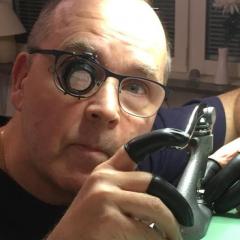-
Recently Browsing
- No registered users viewing this page.
-
Topics
-
Posts
-
Thanks all. Movement is a Helvetia 800C. Don't know any history e.g. if the broken mainspring is original. Watch was bought recently as non-working. Really interesting piece that Jon, thanks. I'd only been thinking of length relating to power reserve. I don't have a mainspring winder (yet) so I'd like to avoid winding the spring into the barrel by hand. The old spring measures at 1.60 x .11 x ~290. Sorry, can't be exact on the length. The piece I still have is 275, but the second piece escaped during measurement. Best measurement I had for it was ~13. The micrometer does zero accurately so I'm pretty confident of the .11 Also, I'm getting the barrel ID at 9.5 on a vernier. I'm now wondering about going with a .11 spring? Given all of the above, maybe 1.60 x .11 x 300 x 9? Any thoughts? Cheers.
-
Funny that you should bring this up. I was thinking about it just the other day. What happens if something happens to @Mark? The social bit is fantastic and I would miss it dearly, but I worry even more about the content. Together we have created a gold mine of information which would be more or less irreplaceable if the site should disappear. People (often with a lot of knowledge) come and go. I sometimes wonder what happened to them and miss them. We have no idea unless we have some private contact information. When I was new here I saw a lot of posts by @Lawson. He had a true fire in his heart for horology and was asking for an apprenticeship in his signature. I found that very inspiring and often wondered what happened. Is the fire still burning? Did he get an apprenticeship?
-
By Neverenoughwatches · Posted
I dont like to give up things that i enjoy Tom. So my next question is how are we going to prepare for that inevitability and what are we going to do about it. Its not just about funding it but I did pick up on something that Mark said once. It doesnt run on fresh air , what if it becomes a burden or an unnecessary cost or for any other reason that i wont get into. We all know life can change in an instant, my life has been so up and down for about 8 years and was only just beginning to level itself out. -
What I especially like is that this forum is not full of ads. There are some but they're not interfering. No ads between posts like one certain big watch forum. Browsing is also very easy and light for a mobile device. I'm glad there's still room for old school forums like this. I'm a member in many facebook groups but there's really no long term discussion and if you see an interesting post you might never find it again if needed.
-








Recommended Posts
Join the conversation
You can post now and register later. If you have an account, sign in now to post with your account.
Note: Your post will require moderator approval before it will be visible.